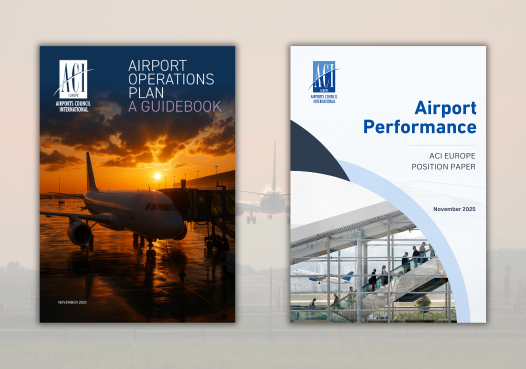Airports lead a new era of performance management — with the passenger at the core

ACI EUROPE releases industry guidance for systemic, collaborative and data‑enabled approaches to airport performance and Airport Operations Plans
Busan, Republic of Korea: At the 2025 ACI Airports Innovate conference taking place in Busan, Republic of Korea from 25‑27 November, ACI EUROPE has renewed its call for a mind shift on capacity and performance management at Europe’s airports, with the passenger at the heart of this vision.
AIRPORTS AS MASTERS OF THEIR PERFORMANCE
Effective performance management requires airports to have a clear operational overview — particularly of how schedules are being met through aircraft turnaround processes. This enables targeted action in collaboration with ground handlers, airlines, Air Navigation Service Providers and the Network Manager.
The performance of an airport is influenced by many factors, with inputs from a wide body of stakeholders. In the race to deliver high operational performance, airports are both participants and referees — as well as the location of the start and finish line. The disrupting factors range from adverse weather and airspace disruptions to local capacity constraints, maintenance, or workforce shortages. While such occurrences may be extraordinary, day‑to‑day performance faces the same exposure to disruptions and structural shortcomings. Both require continuous monitoring and proactive management to safeguard efficiency and reliability — a role airports are naturally predisposed to fulfil as the central connectors for all aviation stakeholders.
ACI EUROPE argues that this evolution is nothing short of a strategic imperative, motivated by the goal of getting passengers where they need to be, on time. Performance management should no longer be viewed as an after‑the‑fact reporting exercise but as a proactive, data‑driven discipline — one that positions airports as the masters of their performance, orchestrating the entire ecosystem to achieve shared operational goals while maintaining safety and sustainability.
A NEW FRAMEWORK FOR PERFORMANCE COORDINATION AND LEADERSHIP
To support this paradigm shift, ACI EUROPE today releases two strategic publications:
- the Airport Performance Position Paper, outlining how airports can lead the move from reactive to predictive performance management.
This strategic paper focuses on the need for airports to shift from measuring outputs to managing inputs. Moving from reactive indicators such as delays and on‑time performance towards leading factors — like gate and stand allocation, asset readiness, resource planning, and process reliability — will unlock new levels of predictability and efficiency. This means on‑time arrivals for passengers, reliable turnaround times, and potentially enhanced use of available airport capacity.
- the Airport Operations Plan (AOP) Guidebook, a practical framework for delivering operational excellence through collaboration and real‑time data.
The AOP Guidebook provides a detailed roadmap for airports to establish a single, collaboratively agreed rolling plan, integrating airside and landside operations and fostering a shared situational awareness across all stakeholders. It is built on four interlinked performance services: Steer, Monitor, Manage, and Post‑Operations Analysis.
By aligning these services with key performance indicators and demand‑capacity balancing tools, the AOP enables airports to anticipate and mitigate disruptions, manage complexity, and enhance resilience. This approach helps airports recover swiftly from events such as weather disruptions, strikes, or system outages — while maintaining optimal service for passengers and stakeholders.
Crucially, the AOP is embedded in Europe’s wider digital transformation of Air Traffic Management under the SESAR Common Project 1 Regulation, ensuring interoperability with the Network Operations Plan (NOP) managed by EUROCONTROL. Together, these systems allow local operational data to inform network‑wide decision‑making, reducing delays, optimising flow management, and improving the predictability of air transport across the continent.
OPERATIONAL EXCELLENCE THROUGH COLLABORATION
As both the Airport Performance Position Paper and the AOP Guidebook make clear, achieving operational excellence depends on collaborative and coordinated action across the entire aviation ecosystem. Airports must take the lead — not by assuming the roles of others, but by bringing all actors to the table.
ACI EUROPE is therefore calling on airlines, ground handlers, ANSPs, slot coordinators, and regulators to align their efforts with and support airport‑led performance frameworks. Predictable, data‑driven cooperation, such as the integration of the Airport Operations Plan with the Network Operations Plan, is essential to achieving a truly resilient and sustainable network.
Olivier Jankovec, ACI EUROPE Director General said: “Running an airport is too often akin to managing a factory you have invested in without being able to really control its throughput and performance. That needs to change. The constraints we face in Europe on developing physical capacity along with the sustainability imperative and increased disruptions — notably from new and hybrid threats — only mean one thing. That airports need to be recognised and empowered to become the masters of their own capacity and performance. This must also include the revision of European airport slot rules, to ensure more transparency and efficiency — and also safeguard the integrity and competitiveness of our aviation market.”

